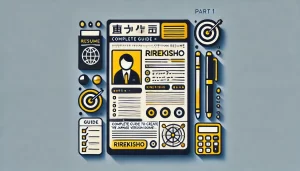Welcome to part two of our three-part series, “Complete Guide to Mastering the Japanese Style Resume.” In this series, we’ll cover the three main types of Japanese resumes:
- 履歴書 (Rirekisho)
- A general overview of your career and basic information.
- 技術経歴書 (Gijutsu Keirekisho)
- A detailed document about your work experience, skills, and projects, especially for engineers.
- 職務経歴書 (Shokumu Keirekisho)
- A detailed document about your work experience, skills, and projects, geared towards business professionals.
If you haven’t created a 履歴書 (Rirekisho) yet, go check out the part one of this series
https://jellyfish-g.co.jp/techport_japan/mastering-the-japanese-style-resumes-complete-guide-for-the-japanese-job-market-part-1-rirekisho-履歴書/
In this second part, we’ll focus on how to create the 技術経歴書 (Gijutsu Keirekisho), a extremely important document for engineering professionals to tell the employer about your work experience, skills, and projects.
It’s gonna be a long one, so prepare a cup of tea, and let’s do it.
Why Do We Need the 技術経歴書 (Gijutsu Keirekisho)?
Unlike the 履歴書 (Rirekisho) which is an excellent tool that provides a snapshot of your life, the 技術経歴書 (Gijutsu Keirekisho) is a must-have document for you to tell the potential employer everything about your technical skills, professional experience and your ability to gengo-ka suru.
“言語化する” (gengo-ka suru) means “to verbalize” or “to put into words” in English. It refers to the process of expressing thoughts, feelings, or ideas using language.
A perfect 技術経歴書 (Gijutsu Keirekisho) demonstrate your professionalism and showcase your experience in a well-structured manner. If there is a document you can go without, this is not the one! Without this document is like applying for a job without any experience.
Section 1: Personal Information (個人情報)

- Name (氏名)
-
Write your full name according to your Passport in Roman Letters or Kanji (if applicable), and Furigana (phonetic reading).
- Gender (性別), Age (年齢), Nearest Station/Address (最寄駅/住所)
-
Address (住所): Write your full address.
- Highest Education/School Name (最終学歴学校名)
-
Provide the official school name in English or Japanese.
- Major (専攻)
-
Provide the official name for the major you studied in.
- Remarks (備考)
-
Write down any remarks you wish to let the reader know.
Section 2: Technical Background (技術経験)

- Technical Skill Table:
-
List your technical skills in each category and assign a mark to indicate your level of expertise.
◎ – More than 1 year of experience and is an expert in it.
〇 – Have some experience and is comfortable with it.
△ – Has knowledge about it but no real experience - Self-PR (自己PR)
-
- Highlight Key Technical Strengths: Mention any significant experience that demonstrate your capabilities.
- Personal Traits: Highlight personal traits that are beneficial in a work environment, such as teamwork, leadership, and problem-solving abilities.
- Future Goals: Show your commitment to growing as an individual.
Section 3: Project Experience (プロジェクト経験)

- Management Experience (管理経験)
-
Specify the size of the team you have managed and the duration of your management experience.
- Work Experience (作業経験):
-
Indicate which stages of the development flow you have experience in.
- Strengths and Specialties (得意業務):
-
Identify the areas or tasks in which you have the most expertise.
- Technical Expertise (得意技術):
-
Highlight your top technical skills.
Section 4: Language Ability (言語能力)

List your proficient in English and Japanese and indicate your level of proficiency for each category
– Reading
– Writing
– Speaking
Section 5: Work History(業務経歴)

This section is perhaps the most important section of all.
It is THE section to describe your main responsibilities and notable achievements for each project.
- Period (期間)
-
Indicate the start and end dates of your contribution to the project.
- System Name and Responsibilities (システム名および担当作業)
-
Highlight your main responsibilities, notable achievements and reasons of your contribution.
- OS・Language・DB etc. (OS・言語・DBなど)
-
List the technologies you used in the project.
This will be cross-checked with the technical skills listed in section 2. - Role (担当)
-
Indicate your role in the project: SE, PG, TL, PM etc.
- Scope of Work (作業範囲)
-
Indicate which stages of the project you have experienced in details.
The 技術経歴書 (Gijutsu Keirekisho) is your golden ticket to success.
It leaves a positive impression and gives potential employers a clear understanding of your technical experience and areas of expertise.
Stay tuned for the next part of our series, part 3, where we’ll explore the other format to showcase your experience and work history, 職務経歴書 (Shokumu Keirekisho) in detail.
Until then, and Happy Job Hunting!








What do you think? Leave Us a Comment!